With its outstanding vanilla flavor, pillowy soft crumb, and creamy vanilla buttercream, this is truly the best vanilla cake I’ve ever had. And after 1 bite, I guarantee you’ll agree.

Out of all the cake recipes on my website, there’s a glaring absence. There’s white cake with a pristine soft crumb, vanilla naked cake with a flavorful tight crumb, and checkerboard cake with a whimsical design.
What about a classic vanilla layer cake draped in vanilla buttercream? I already have homemade vanilla cupcakes and a vanilla 6 inch cake covered and now in all its crowning glory (and after plenty recipe testing catastrophes), I present you with cake perfection:
This is the best vanilla cake I’ve ever had.
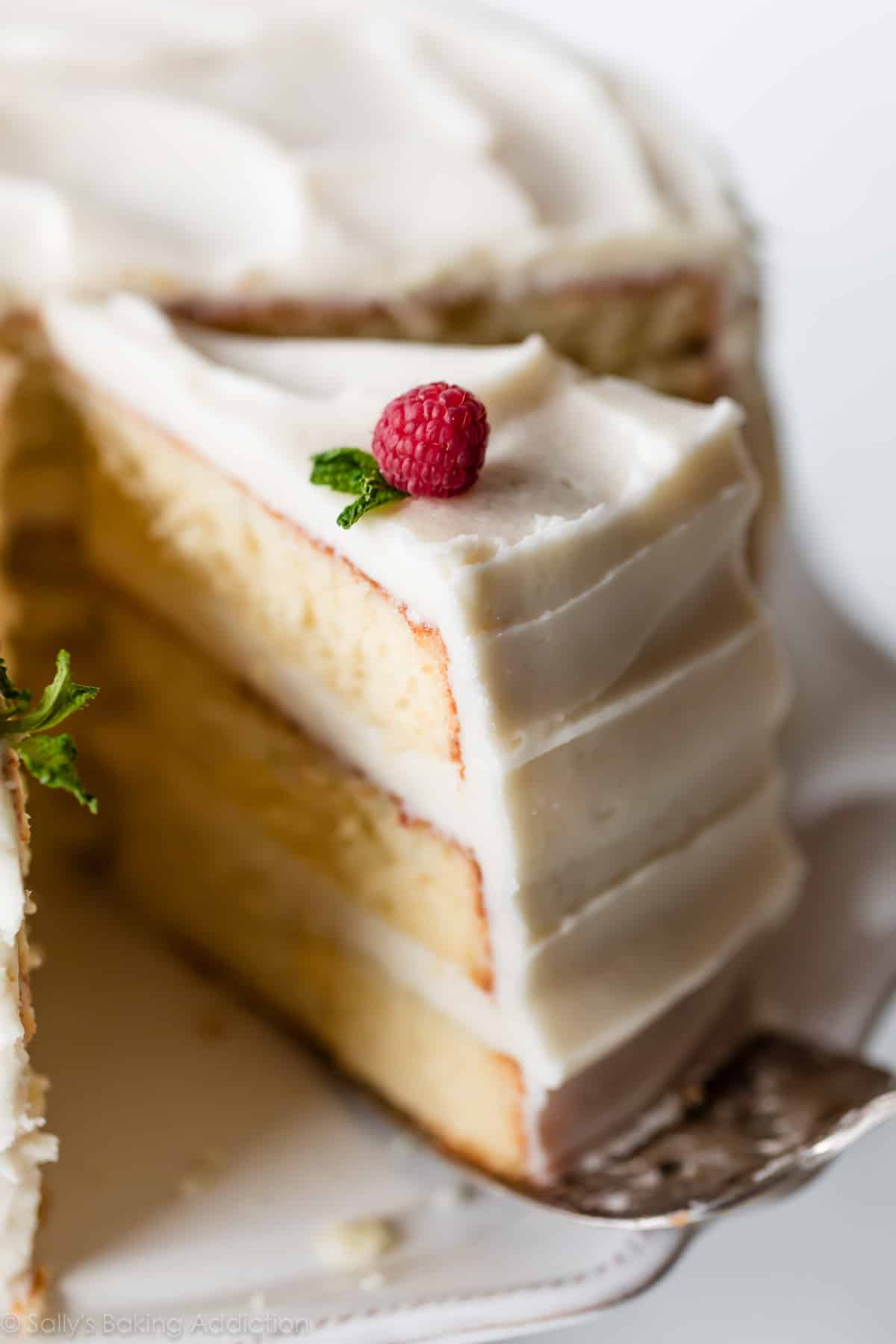
What Makes it the Best Vanilla Cake?
Let’s count the ways!
- Soft, light crumb from cake flour
- Fluffy from extra egg whites
- Buttery and cakey from creamed butter
- Stick-to-your-fork moist from eggs & buttermilk
- Extra flavor from pure vanilla extract
Not to mention its versatility: This vanilla cake batter is strong enough for shaped cakes, tiered cakes (see the slight variation in my homemade wedding cake recipe), and holds up beautifully under fondant. Use this batter for vanilla cupcakes, Bundt cake, or even piñata cake. It’s classy enough for a wedding celebration, but unassuming enough for a big family dinner.
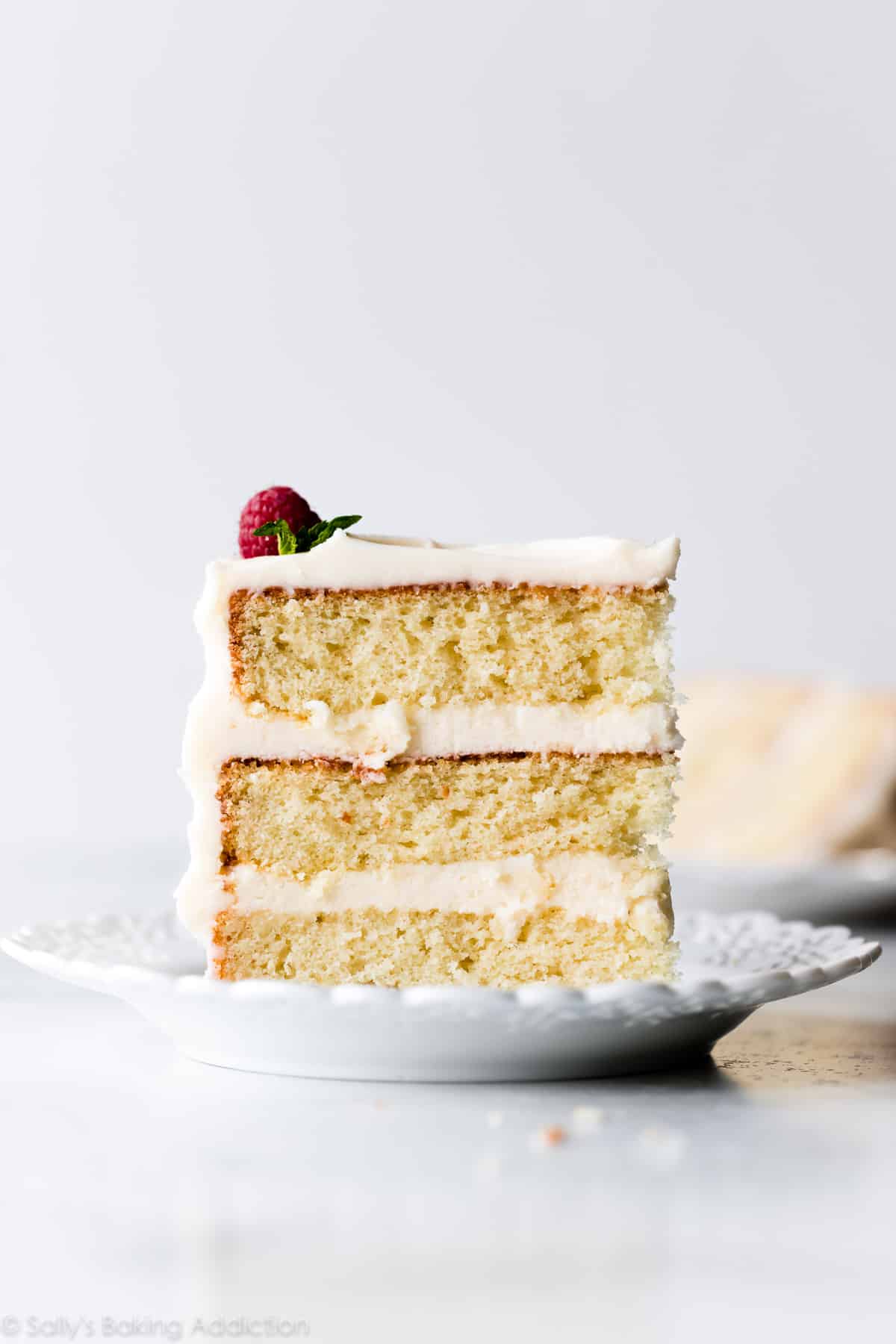
Behind the Vanilla Cake Recipe
After years of cake successes and flops, I’m confident in this homemade vanilla cake. During my recipe testing, I combined my white cake recipe and naked cake recipe. These are two reader favorites and I knew they’d be the best starting point. At first there were too many eggs and I quickly learned sifting cake flour was NOT doing any favors.
You need the following power ingredients:
- Cake Flour: If you want a fluffy and soft bakery-style vanilla cake, cake flour is the secret. The cake will be denser and heavier using all-purpose flour.
- Eggs & 2 additional egg whites: 3 whole eggs provide structure, moisture, and richness. 2 extra egg whites keep the cake light and airy. I don’t recommend using 4 whole eggs; stick to the 3 egg & 2 egg white combination.
- Baking Powder & Baking Soda: Remember the differences in baking powder vs baking soda and why we use both in some recipes? Using enough baking powder to give these layers height gave the cake a bitter aftertaste. Baking soda allows us to use less baking powder.
- Buttermilk: Buttermilk is an acidic ingredient and baking soda requires an acid to work. Plus buttermilk yields an EXTRA moist cake crumb. See recipe note about the alternative.
For more prominent vanilla flavor, use homemade vanilla extract. (What a fun DIY gift!) This vanilla cake batter is moderately thick and fits perfectly in 3 9-inch cake pans. We actually use the same exact batter to make snickerdoodle cake.
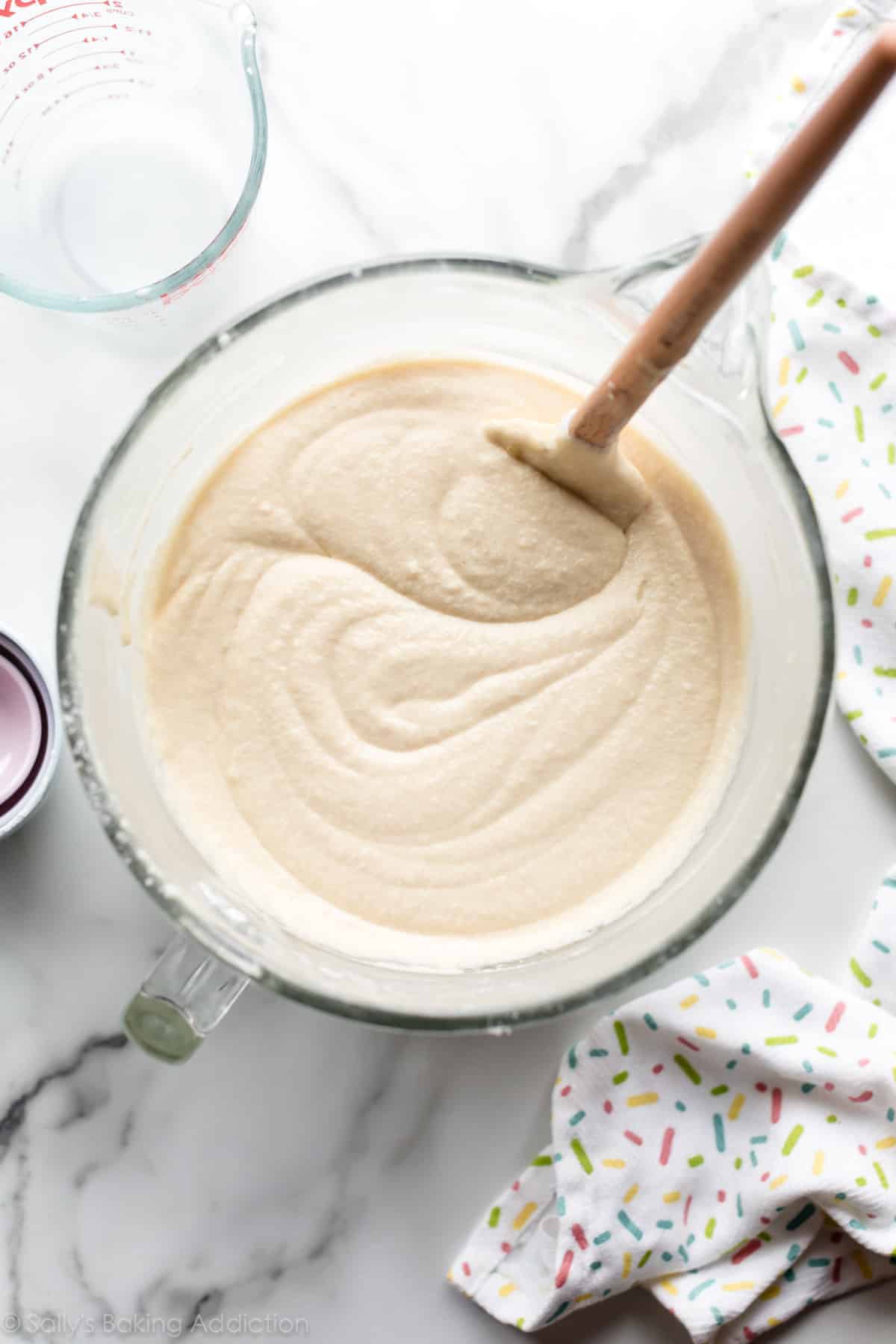
Do you know how to level a cake? Let me help. It’s really easy. You can use a fancy cake leveler, but I use a serrated knife. Carefully slice off the tippy top of the cooled cake layers, creating a flat surface. Leveling cakes doesn’t require a ruler, talent, or any mathematical equations. Instead, just use your eyes, hands, and a knife.
Leveling the cake layers promises a straight and sturdy layer cake.
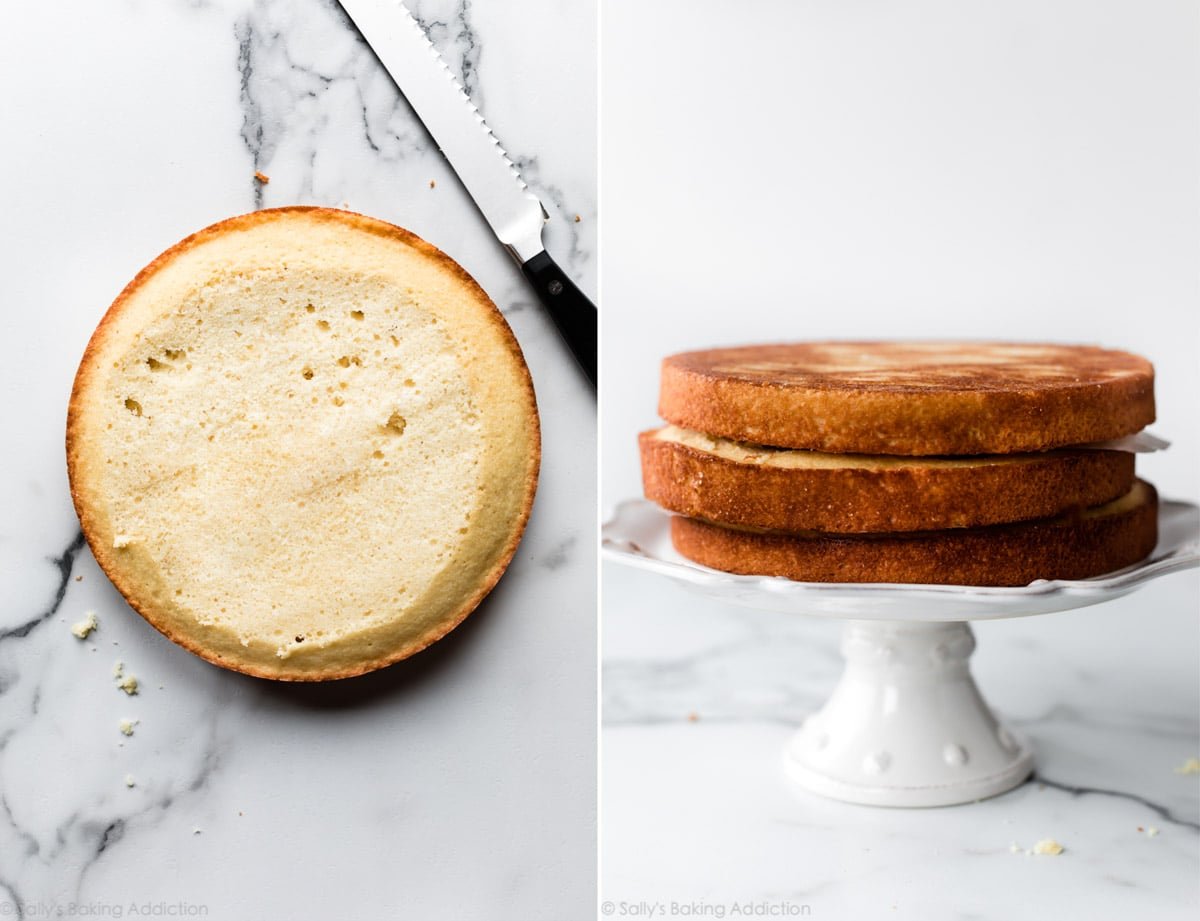
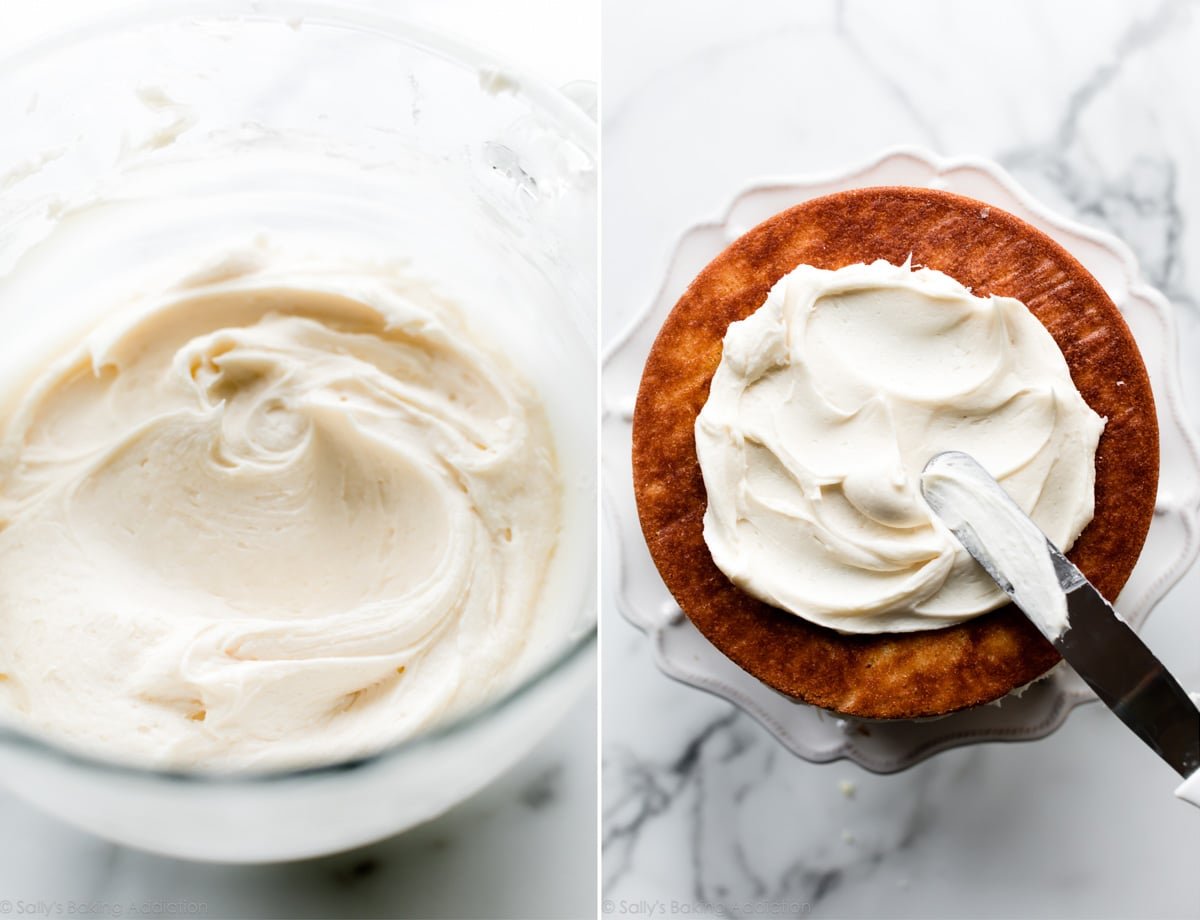
How Much Frosting Between Cake Layers?
I always eyeball the amount of frosting between cake layers, but I measured when I decorated the pictured cake. The vanilla buttercream recipe below yields about 6 cups of frosting. I recommend you use about 1.5 heaping cups of buttercream between each cake layer and reserve the last 3 cups for outside the cake. If you are going to add a filling such as raspberry cake filling, you’ll use less frosting between the layers.
Cake Decoration Inspiration: For a simple look, stick with vanilla buttercream, fresh berries, and mint sprigs. You can also decorate with chocolate buttercream (I recommend the same amount from this piñata cake), rainbow sprinkles, or even beautiful buttercream flowers.
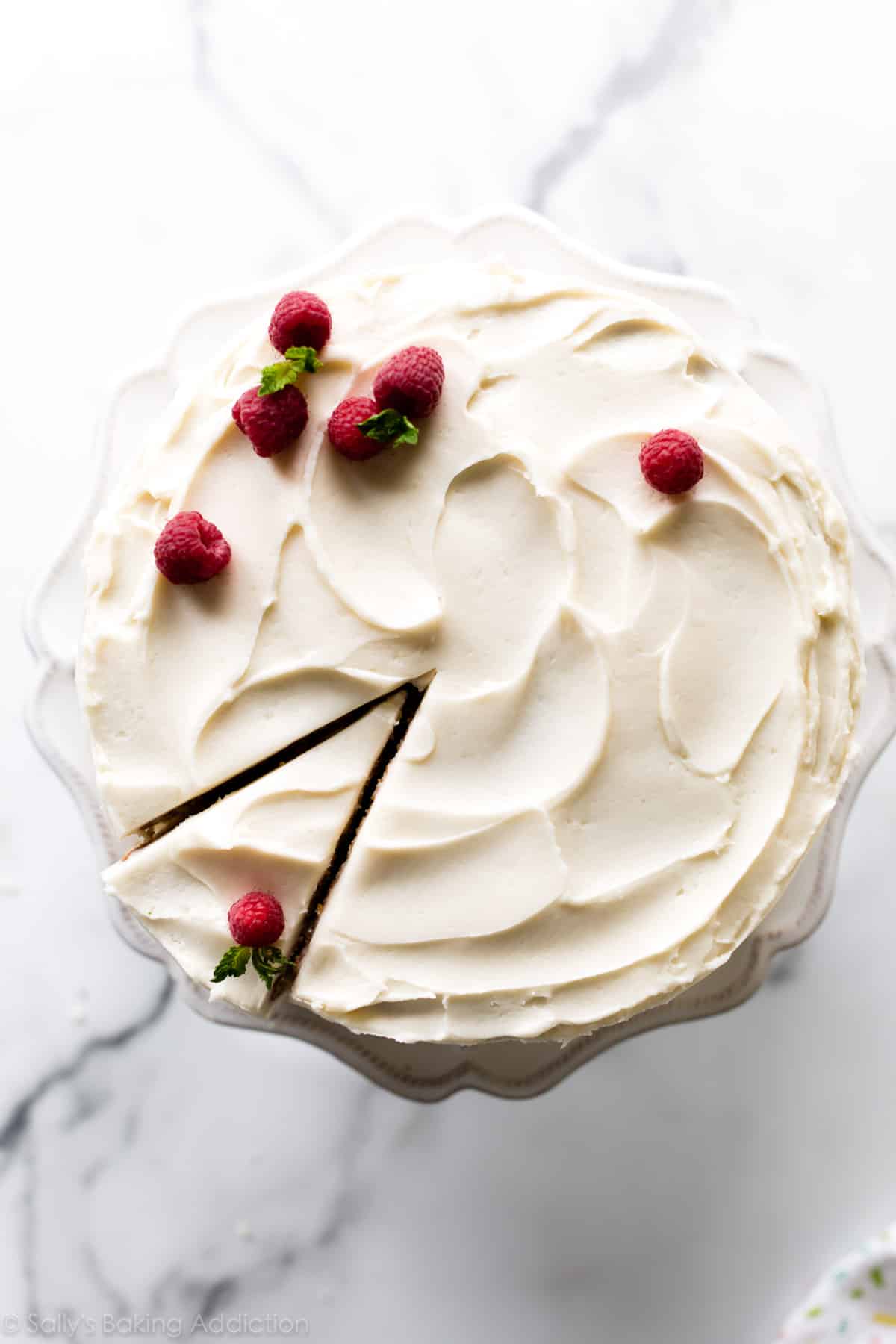
Homemade Vanilla Cake Success Tips
Learn from my mistakes and bake the best cake on the 1st try!
- Follow the recipe closely. Use each power ingredient listed.
- Use room temperature ingredients. The batter mixes together evenly when all the cake ingredients are roughly the same temperature. This also reduces the risk of over-mixing and over-baking. Set out your ingredients 1 hour before beginning. Read more about why room temperature ingredients are important.
- Line your cake pans with parchment. Place your cake pans on a large sheet of parchment paper. Trace the bottom of the cake pan with a pencil. Cut parchment paper into rounds. Grease the pan and the parchment paper. Parchment paper rounds guarantee seamless removal from the pan because the cake slides right out.
- Cool cake layers completely. I’ve tried taking shortcuts by assembling a layer cake with semi-warm cake layers. Well, the frosting completely melts and causes the entire cake to collapse. Make sure each layer is cool– refrigerate or freeze the layers if you need to!
- Refrigerate decorated cake. After frosting the cake, place it in the refrigerator for at least 1 hour. This is optional, but it sets the frosting and cake layers. You’ll get beautifully clean slices because the crumbs are cool and tight.
Great read: Check out Tessa’s Top 10 Best Layer Cake Tips.
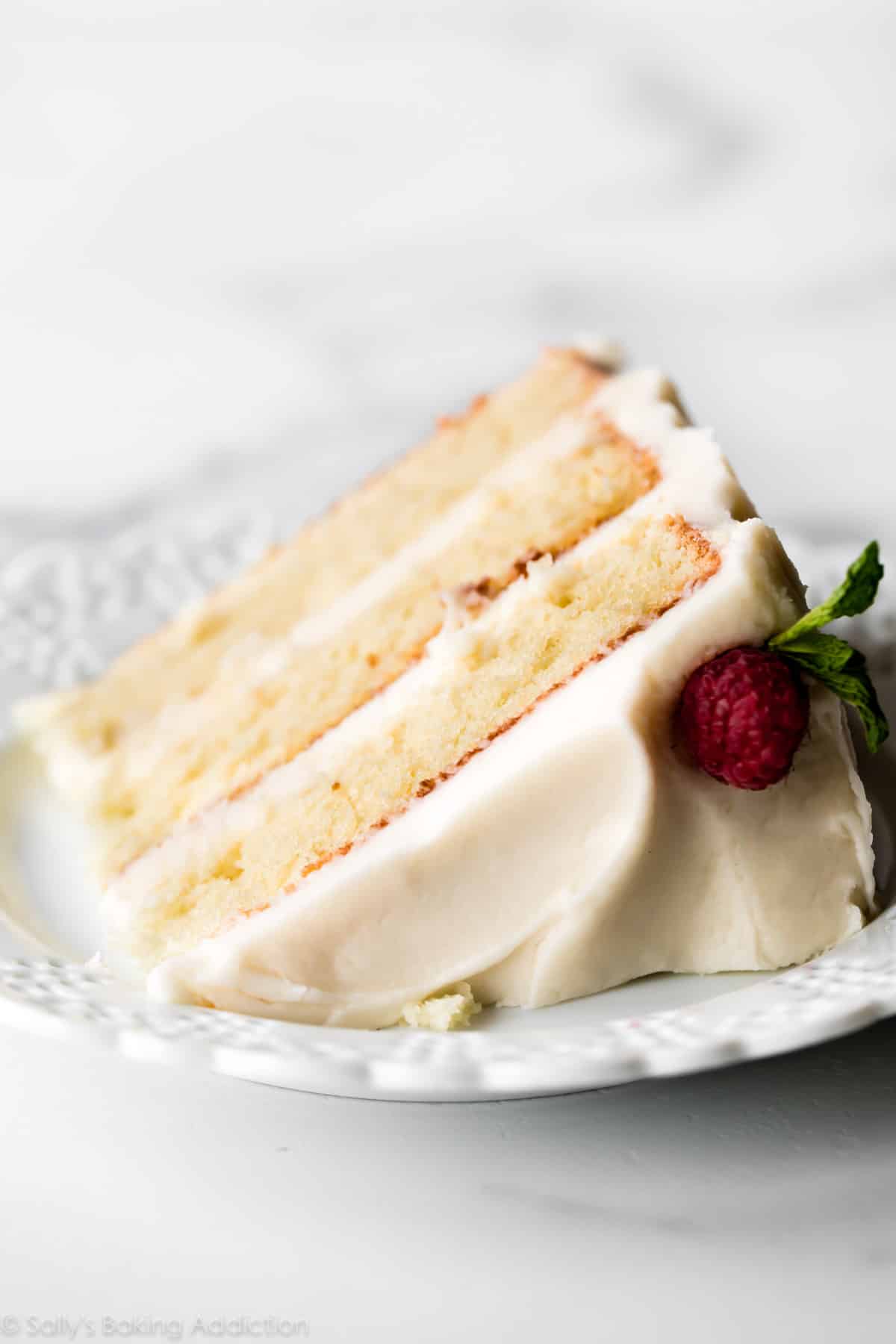
Finding the perfect vanilla cake recipe requires a celebration. Luckily we have cake!!!
More Classic Cake Recipes
And here is my perfected vanilla cupcakes recipe.
Print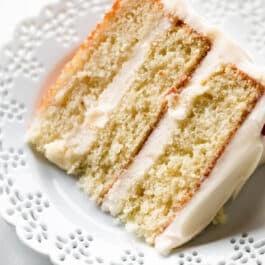
Best Vanilla Cake
- Prep Time: 35 minutes
- Cook Time: 25 minutes
- Total Time: 4 hours (includes cooling)
- Yield: 12-14 servings
- Category: Dessert
- Method: Baking
- Cuisine: American
Description
With its outstanding vanilla flavor, pillowy soft crumb, and creamy vanilla buttercream, this is truly the best vanilla cake I’ve ever had. Make sure you read through the recipe and recipe notes before beginning. This recipe yields approximately 8 cups of batter which is helpful if you need this batter for different cake pan sizes and conversions.
Ingredients
- 3 and 2/3 cups (433g) cake flour (spooned & leveled)
- 1 teaspoon salt
- 2 teaspoons baking powder
- 3/4 teaspoon baking soda
- 1 and 1/2 cups (340g) unsalted butter, softened to room temperature
- 2 cups (400g) granulated sugar
- 3 large eggs + 2 additional egg whites, at room temperature*
- 1 Tablespoon pure vanilla extract (yes, Tbsp!)
- 1 and 1/2 cups (360ml) buttermilk, at room temperature*
Vanilla Buttercream
- 1 and 1/2 cups (340g) unsalted butter, softened to room temperature
- 5 and 1/2 cups (650g) confectioners’ sugar
- 1/3 cup (80ml) whole milk or heavy cream
- 1 and 1/2 teaspoons pure vanilla extract
- 1/8 teaspoon salt
Instructions
- Preheat oven to 350°F (177°C). Grease three 9-inch cake pans, line with parchment paper rounds, then grease the parchment paper. Parchment paper helps the cakes seamlessly release from the pans. (If it’s helpful, see this parchment paper rounds for cakes video & post.)
- Make the cake: Whisk the cake flour, salt, baking powder, and baking soda together. Set aside.
- Using a handheld or stand mixer fitted with a paddle or whisk attachment, beat the butter and sugar together on high speed until smooth and creamy, about 3 minutes. Scrape down the sides and up the bottom of the bowl with a silicone spatula as needed. Beat in the 3 eggs, 2 egg whites, and vanilla extract on high speed until combined, about 2 minutes. (Mixture will look curdled as a result of the egg liquid and solid butter combining.) Scrape down the sides and up the bottom of the bowl as needed. With the mixer on low speed, add the dry ingredients just until combined. With the mixer still running on low, pour in the buttermilk and mix just until combined. You may need to whisk it all by hand to make sure there are no lumps at the bottom of the bowl. The batter will be slightly thick.
- Pour batter evenly into cake pans. Weigh them to ensure accuracy, if desired. Bake for around 23-26 minutes or until the cakes are baked through. To test for doneness, insert a toothpick into the center of the cake. If it comes out clean, it’s done. Allow cakes to cool completely in the pans set on a wire cooling rack. The cakes must be completely cool before frosting and assembling.
- Make the frosting: In a large bowl using a handheld mixer or stand mixer fitted with a whisk or paddle attachment, beat the butter on medium speed until creamy, about 2 minutes. Add confectioners’ sugar, milk, vanilla extract, and salt with the mixer running on low. Increase to high speed and beat for 2 minutes. Add more confectioners’ sugar if frosting is too thin, more milk if frosting is too thick, or an extra pinch of salt if frosting is too sweet.
- Assemble and decorate: Using a large serrated knife, slice a thin layer off the tops of the cakes to create a flat surface. Discard (or crumble over ice cream!). Place 1 cake layer on your cake stand, cake turntable, or serving plate. Evenly cover the top with about 1 and 1/2 cups of frosting. Top with 2nd cake layer and evenly cover the top with about 1 and 1/2 cups of frosting. Top with the third cake layer. Spread the remaining frosting all over the top and sides. I use and recommend an icing spatula to apply the frosting.
- Refrigerate cake for at least 1 hour before slicing. This helps the cake hold its shape when cutting.
- Cover leftover cake tightly and store in the refrigerator for up to 5 days.
Notes
- Make Ahead & Freezing Instructions: The cake layers can be baked, cooled, and covered tightly at room temperature overnight. Likewise, the frosting can be prepared then covered and refrigerated overnight. Let the frosting sit at room temperature to slightly soften for 10 minutes before assembling and frosting. Frosted cake or unfrosted cake layers can be frozen up to 2-3 months. Thaw overnight in the refrigerator and bring to room temperature before decorating/serving. See how to freeze cakes for detailed instructions.
- Special Tools (affiliate links): 9-inch Round Cake Pans | Glass Mixing Bowl | Whisk | Electric Mixer (Handheld or Stand) | Silicone Spatula | Kitchen Scale (optional) | Cooling Rack | Large Icing Spatula | Cake Turntable | Bench Scraper | Cake Carrier (for storing and transporting)
- 9×13 Inch Cake: I recommend using my white cake batter instead. Both use similar ingredients and produce a deliciously light vanilla cake. See recipe notes for the 9×13 inch version.
- 2 Layer Cake: I recommend using my 2 layer white cake batter instead. Both use similar ingredients and produce a deliciously light vanilla cake.
- Bundt Cake: This vanilla cake batter will fit into a 10-12 cup or larger Bundt pan. I’m unsure of the exact bake time (likely around an hour), but use a toothpick to test for doneness. Same oven temperature.
- Cupcakes: Fill cupcake liners 2/3 full. Bake at 350°F (177°C) for 19-21 minutes. Yields about 3 dozen. Or try my vanilla cupcakes recipe.
- Cake Flour: To prevent a dry-tasting cake, make sure you are spooning and leveling the flour or weighing it. For the best results, I strongly recommend cake flour. You can find it in the baking aisle and I have many more recipes using it. Usually a homemade cake flour substitute works, but this recipe uses far too much cake flour and the homemade substitute is not ideal.
- Eggs: 3 whole eggs provide structure, moisture, and richness. 2 extra egg whites keep the cake light and airy. I don’t recommend using 4 whole eggs; stick to the 3 egg & 2 egg white combination. Here are recipes using leftover egg yolks.
- Buttermilk: If you don’t have buttermilk, you can make a DIY sour milk substitute. Add 2 teaspoons of white vinegar or lemon juice to a liquid measuring cup. Then add enough whole milk to the same measuring cup until it reaches 1 and 1/2 cups. (In a pinch, lower fat or nondairy milks work for this soured milk, but the cake won’t taste as moist or rich.) Stir it around and let sit for 5 minutes. The homemade “buttermilk” will be somewhat curdled and ready to use in the recipe.
- Why is everything at room temperature? All refrigerated items should be at room temperature so the batter mixes together easily and evenly. Read more about why room temperature ingredients are important.
- Want chocolate frosting instead? I recommend the recipe/amount of chocolate frosting I use for Piñata Cake.
- Sprinkle Cake: To make a sprinkle cake, fold about 3/4 cup (135g) of sprinkles into the cake batter. Avoid nonpareils (the little balls), which tend to bleed their color. Or try this confetti birthday cake, which is quite similar to this recipe.




















I really love this recipe. However, I have trouble frosting it because I find it very crumbly. I’m using your vanilla frosting recipe. Any tips for me ?
Hi Mary! Is the cake completely cooled? Does the frosting seem too hard? If the frosting is too stiff to spread, you can beat in a little more milk/cream.
Love this recipe, and the buttercream icing is the best I have ever had or made. I shared some with family and coworkers and they loved it. Definitely my go to for when I want a vanilla cake. Will be making again soon. Thanks so much for sharing your recipes.
Could I use an 8×2 inch pan instead?
Hi Emmie, you can use this recipe with 8 inch cake pans for slightly thicker layers in a three layer cake. You may need an extra minute or two of bake time since they layers will be thicker – use a toothpick to test for doneness. Or, you can fill the 8 inch pans a little less and use the leftover batter for some cupcakes.
Hi!! I want to make this recipe, I’ll stick to the exact instructions for the batter but wondering if I could get away with putting a light layer of strawberries in between? And could I switch out the buttercream frosting for whipped cream frosting? Thanks so much Sally!!
Absolutely! Enjoy.
I had go-to recipe I’ve been making for YEARS…on a whim, I decided to try this one. You’ve outdone yourself again, Sally. Absolute perfection. I used your substitute buttermilk option (milk + vinegar) and would love to try again using the real deal… but had such great results with this version, I wouldn’t let that deter me again. It always amazes me when basically the same ingredients in slightly different ratios can yield such different results. Can’t wait to make again!
Hi Carrie, we’re so glad you loved this!
Hi – I’m planning to make your vanilla cake but can you confirm something about the VANILLA EXTRACT in the recipe please….? I’m in the UK and would normally use VANILLA ESSENCE. Should I hunt down some extract, or will the essence be the same?
Hi Elizabeth! Vanilla extract is a natural flavor, and more strong than synthetic vanilla essence. If you can find extract, we would use it, but essence will work as well.
I have searched far and wide for the perfect moist, fluffy vanilla cake. Today, I followed your directions (including spooning the flour, which was a first for me. ) and baked one! Thank you a million times for this recipe. It is now my go-to. P.S. I made your raspberry filling & lemon curd recipes last night. Perfection!
I am not a fan of vanilla cake but my son is, so I made him this and omg, I cannot stop eating it! It is absolutely delicious!
My family simply adored this cake. I made it for my husband’s birthday. Thank you!
Hi Sally! I LOVE this recipe! I used it last year for my husbands bday and I’m repeating it this year. Can I substitute vanilla paste for a more intense flavor, or would the paste “weigh down” the cake?
Hi Karen, yes, you can use the same amount of vanilla bean paste in place of the vanilla extract. That be wonderful in this cake!
How to substitute cake flour for all purpose flour? Canada doesn’t sell cake flower
Hi Emilee, You can make this DIY Cake Flour Substitute.
I’m from Canada and you can definitely find cake and pastry flour in Canada! 🙂
I love this cake
Hi Sally! Long time follower, first time commenter here! First off, I just want to say I LOVE all your recipes, thank you for doing so much work testing and making sure you are putting out the best quality recipes! I’ve made this vanilla cake recipe several times before and it has always been a hit! One time I even substituted the vanilla extract for almond extract for a bridal shower and everyone raved about it. But I was just wondering do you have a specific vanilla almond cake recipe? I know you could always substitute extracts but just wondering if you had a tried and true almond cake recipe? Thanks
Hi Becca, we’re so glad to hear this is a favorite for you! We don’t have an almond cake recipe, but as you mention, our vanilla cakes are great with almond extract. Thank you for making and trusting our recipes!
Been baking cakes for only 3 yrs and in search of a reliable vanilla cake recipe. I hope to make “a cake” for my son’s 20th birthday. I have a Wilton number / alphabet tin (dark, non-stick). The surface area of 1 letter is equal to 2 x 8” round tins. If I use this recipe in this tin, what height would the cake be? My target is 6cm (about 2.25”).I hope to slice the cake into 2 layers then frost. I understand it is easier to bake layer by layer but for 3 letters, I will need to bake 6 times! If this plan is workable, what would be the estimated baking time, of course I will need to back up by toothpick test. Thank you in advance 🙂
Hi May Ann, without baking the cakes in those specific pans, it’s hard to know the exact height or bake time. As you mention, keep a close eye on them and use a toothpick to test for doneness. We hope the cakes are a hit!
Very good. I followed the recipe to a t and it came out perfectly
Hi Sally! I am interested in baking this cake for my sister’s upcoming engagement party. However, she wants her cake to be heart-shaped. Would the baking time be the same in a heart-shaped pan that is 9x9x2 in.? Additionally, would you recommend using a light or dark-colored baking pan? Thanks a bunch, we love your recipes!
Hi Veronica, we are unsure of the exact timing since we haven’t tested a heart-shaped pan ourselves, but it should be similar. Keep a close eye on it and use a toothpick to test for doneness. We typically recommend a light-colored pan, as dark pans can heat faster and cause baked goods to become too brown on the edges. Hope the cake is a hit!
What do you think about using a cream cheese frosting on this cake?
Hi Rosanne, cream cheese frosting would be delicious here!